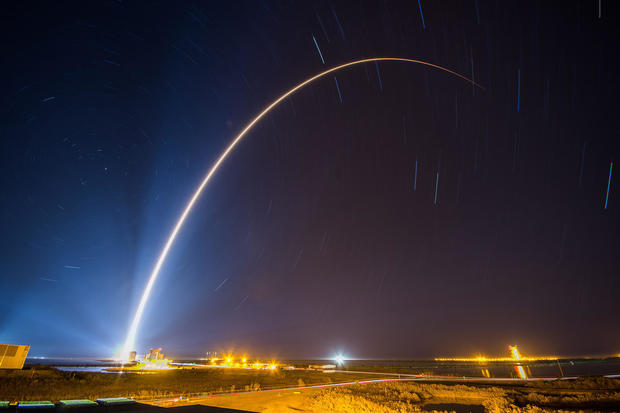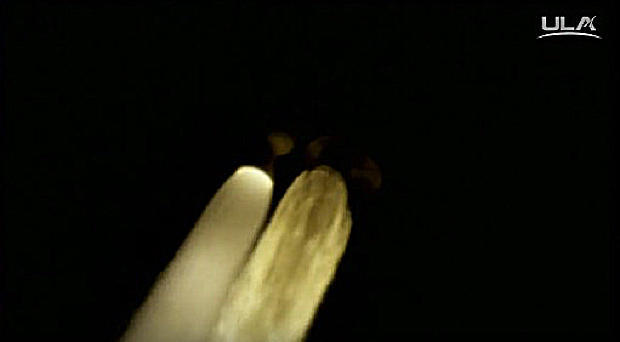Atlas 5 launches missile-detecting satellite
One week after launching a spy satellite from California atop a Delta 4 rocket, United Launch Alliance boosted a missile early warning satellite into space aboard an Atlas 5 booster Friday evening after a sky-lighting launch from Cape Canaveral.
With a crescent moon setting in the west, the Atlas 5's Russian-built RD-180 engine thundered to life at 7:48 p.m. ET, followed an instant later by ignition of a single strap-on solid-fuel booster. Trailing a jet of brilliant exhaust, the 194-foot-tall rocket quickly climbed skyward from complex 41 at the Cape Canaveral Air Force Station, arcing away to the east over the Atlantic Ocean.
Liftoff came a day late because of trouble with a liquid oxygen valve in the pad's propellant system, but it was smooth sailing Friday. The strap-on booster burned out and fell away shortly after launch and the ascent continued under the power of the first-stage engine, looking like a fiery "star" in the evening sky.
The first stage fired normally, falling away four minutes after liftoff, and a little less than 10 minutes after that, the rocket's Centaur second stage completed the first of two firings to put the spacecraft into a preliminary orbit.
A second firing 10 minutes later was designed to put the Space Based Infrared System -- SBIRS -- satellite into an elliptical "transfer" orbit with a high point, or apogee, of around 35,850 miles and a low point, or perigee, of 115 miles.
The satellite's on-board thruster will be fired over the next two weeks to circularize the orbit at an altitude of 22,300 miles above the equator. In such geosynchronous orbits, satellites take 24 hours to complete one trip around the planet and thus appear stationary in the sky.
The new satellite will join three other SBIRS (pronounced SIB-ers) spacecraft already in geosynchronous orbit that use telescopes and sophisticated infrared sensors to constantly monitor the world below, on the lookout for the heat generated by a rocket during launch. The SBIRS GEO-4 satellite completes the constellation, providing overlapping global coverage.
The SBIRS system also incorporates data from older Defense Support Program, or DSP, early warning satellites along with stand-alone infrared sensors mounted on other classified military satellites in lower elliptical orbits.
"Missiles, as they fly, create a heat signature, and certainly our adversaries are moving to make that heat signature smaller and smaller, and we are moving to maintain a capability to detect those as we move forward," Col. Dennis Bythewood, director of the Remote Sensing Systems Directorate at Los Angeles Air Force Base, told reporters before launch.
"The missile warning constellation, comprised of both the Defense Support Program and the SBIRS satellites, provides that initial warning to our nation's leaders. So whether there be an actual launch or a false indication of a launch, the missile warning architecture is there to provide the true data that allows us to understand what actually happened."
The SBIRS satellites are built by Lockheed Martin, using sensors provided by Northrup Grumman. SBIRS GEO 3 and 4 are valued at $1.2 billion all together, including the costs of the rockets needed to launch them.
"The Defense Support Program has provided missile warning data since 1970," Bythewood said. "It has been the bedrock of our missile warning constellation and continues to provide phenomenal data.
"However, the sensors that we have on the SBIRS constellation are leaps and bounds ahead of them in capability, and as we launch those and move them into the constellation, we are able to get dimmer targets and keep pace with the missiles that our adversaries are fielding day-to-day."
Along with detecting intercontinental ballistic missiles, the SBIRS sensors are also able to "see" the heat produced by smaller tactical weapons, improving "battlespace awareness" and providing technical intelligence.
"When the system was originally designed in a Cold War era, we were really worried about the Soviet Union and its allies," Bythewood said before the third SBIRS launch last January. "In today's world, and certainly over the last 20 years, the proliferation of missiles outside of that concentrated area has grown demonstrably.
"Regional systems present in Asia and the Middle East are well within the range of our deployed forces. So the SBIRS constellation is tasked with providing timely, reliable and accurate missile warning information to protect our nation and our troops operating abroad."







